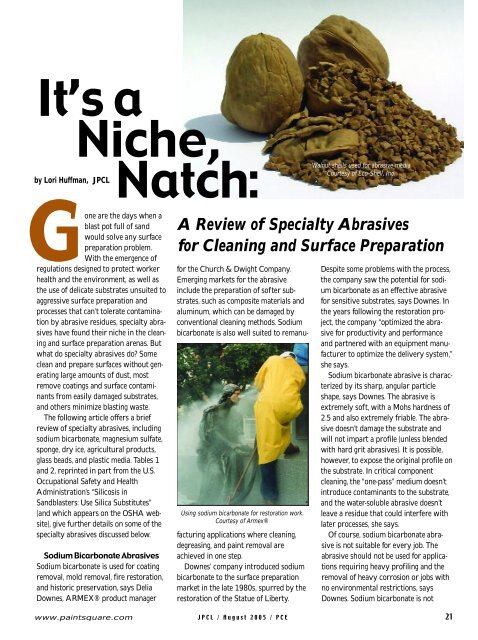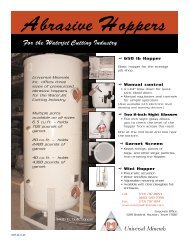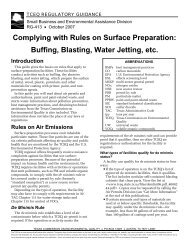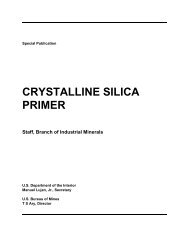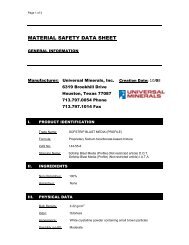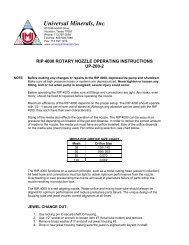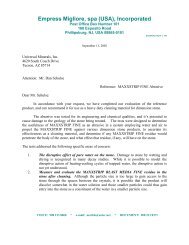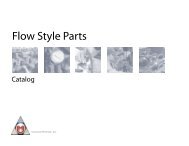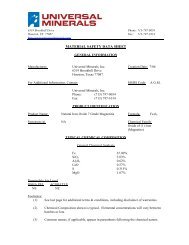Sodium bicarbonate Soda Blast - Universal Minerals, Inc.
Sodium bicarbonate Soda Blast - Universal Minerals, Inc.
Sodium bicarbonate Soda Blast - Universal Minerals, Inc.
Create successful ePaper yourself
Turn your PDF publications into a flip-book with our unique Google optimized e-Paper software.
It’s a<br />
Niche,<br />
by Lori Huffman, JPCL<br />
Gone are the days when a<br />
blast pot full of sand<br />
would solve any surfa c e<br />
preparation problem.<br />
With the emergence of<br />
regulations designed to protect worker<br />
health and the environment, as well as<br />
the use of delicate substrates unsuited to<br />
aggressive surface preparation and<br />
processes that can’t tolerate contamination<br />
by abrasive residues, specialty abrasives<br />
have found their niche in the cleaning<br />
and surface preparation arenas. But<br />
what do specialty abrasives do? Some<br />
clean and prepare surfaces without generating<br />
large amounts of dust, most<br />
remove coatings and surface contaminants<br />
from easily damaged substrates,<br />
and others minimize blasting waste.<br />
The following article offers a brief<br />
review of specialty abrasives, including<br />
sodium <strong>bicarbonate</strong>, magnesium sulfa t e ,<br />
sponge, dry ice, agricultural products,<br />
glass beads, and plastic media. Tables 1<br />
and 2, reprinted in part from the U.S.<br />
Occupational Safety and Health<br />
A d m i n i s t r a t i o n s ’“Silicosis in<br />
Sandblasters: Use Silica Substitutes”<br />
(and which appears on the OSHA website),<br />
give further details on some of the<br />
specialty abrasives discussed below.<br />
<strong>Sodium</strong> Bicarbonate Abrasives<br />
<strong>Sodium</strong> <strong>bicarbonate</strong> is used for coating<br />
removal, mold removal, fire restoration,<br />
and historic preservation, says Delia<br />
Downes, ARMEX® product manager<br />
Natch:<br />
A Review of Specialty Abrasives<br />
for Cleaning and Surface Preparation<br />
Using sodium <strong>bicarbonate</strong> for restoration work.<br />
Courtesy of Armex®<br />
for the Church & Dwight Company.<br />
Emerging markets for the abrasive<br />
include the preparation of softer substrates,<br />
such as composite materials and<br />
aluminum, which can be damaged by<br />
conventional cleaning methods. <strong>Sodium</strong><br />
<strong>bicarbonate</strong> is also well suited to remanufacturing<br />
applications where cleaning,<br />
degreasing, and paint removal are<br />
achieved in one step.<br />
Downes’ company introduced sodium<br />
<strong>bicarbonate</strong> to the surface preparation<br />
market in the late 1980s, spurred by the<br />
restoration of the Statue of Liberty.<br />
Walnut shells used for abrasive media<br />
Courtesy of Eco-Shell, <strong>Inc</strong>.<br />
Despite some problems with the process,<br />
the company saw the potential for sodium<br />
<strong>bicarbonate</strong> as an effective abrasive<br />
for sensitive substrates, says Downes. In<br />
the years following the restoration project,<br />
the company “optimized the abrasive<br />
for productivity and perfo r m a n c e<br />
and partnered with an equipment manufacturer<br />
to optimize the delivery system,”<br />
she says.<br />
<strong>Sodium</strong> <strong>bicarbonate</strong> abrasive is characterized<br />
by its sharp, angular particle<br />
shape, says Downes. The abrasive is<br />
extremely soft, with a Mohs hardness of<br />
2.5 and also extremely friable. The abrasive<br />
doesn’t damage the substrate and<br />
will not impart a profile (unless blended<br />
with hard grit abrasives). It is possible,<br />
h o w e v e r, to expose the original profile on<br />
the substrate. In critical component<br />
cleaning, the “one-pass” medium doesn’t<br />
introduce contaminants to the substrate,<br />
and the water-soluble abrasive doesn’t<br />
leave a residue that could interfere with<br />
later processes, she says.<br />
Of course, sodium <strong>bicarbonate</strong> abrasive<br />
is not suitable for every job. The<br />
abrasive should not be used for applications<br />
requiring heavy profiling and the<br />
removal of heavy corrosion or jobs with<br />
no environmental restrictions, says<br />
Downes. <strong>Sodium</strong> <strong>bicarbonate</strong> is not<br />
www.paintsquare.com<br />
JPCL / August 2005 / PCE<br />
21
appropriate for flexible coatings.<br />
In applications where dusting<br />
c a n ’t be tolerated, sodium <strong>bicarbonate</strong><br />
should not be used. Dust<br />
minimization is best achieved<br />
through the use of negative air, air<br />
scrubbers, and containment, says<br />
Downes. When conditions allow,<br />
water attachments on the nozzles<br />
of surface preparation equipment<br />
can spray a mist of water fo l l o w-<br />
ing the path of the sodium <strong>bicarbonate</strong><br />
abrasive, facilitating suppression<br />
of the dust.<br />
<strong>Sodium</strong> <strong>bicarbonate</strong> abrasive<br />
usually calls for specifically engineered<br />
equipment and operator<br />
training, says Downes. Pe o p l e<br />
familiar with air-driven equipment<br />
can understand the process,<br />
but finesse is necessary, she says.<br />
Table 1: Some Alternatives to Conventional Abrasives*<br />
Abrasive<br />
Aluminum Oxide<br />
Baking <strong>Soda</strong><br />
(<strong>Sodium</strong> Bicarbonate)<br />
Corn Cob Granules<br />
Dry Ice<br />
(Carbon Dioxide)<br />
Garnet<br />
Glass Beads<br />
Nut Shells<br />
Plastic Media<br />
Special Equipment<br />
None Required (Usually Used in<br />
Cabinets or Rooms with Recycling<br />
Equipment)<br />
Yes (Meters Less Product/Min and<br />
Dries Air)<br />
Special Ventilation May Be Required in<br />
Enclosed Areas to Control Combustion<br />
Dry Air Required<br />
None Required (Additional Components<br />
Required in Order to Recycle Media)<br />
None Required (Usually used in <strong>Blast</strong><br />
Cabinets with Recycling Equipment)<br />
Special Ventilation May Be Required in<br />
Enclosed Areas to Control Combustion<br />
None Required (Additional Components<br />
Required in Order to Recycle Media)<br />
Properties<br />
Closely Sized Very Hard<br />
(MOH 8.5-9)<br />
Natural (Flow and Rinse Agents<br />
Added) Water Soluble Non-Sparking<br />
Non-Flammable<br />
Medium Hardness (MOH 4.5)<br />
Non-Sparking<br />
Natural Gas in Solid State<br />
Very Hard (MOH 8) Very Heavy<br />
(S.G. 4.1) Subangular<br />
Manufactured of <strong>Soda</strong> Lime Glass<br />
Soft Non-Sparking<br />
Natural Mineral Hard (MOH 6.5-7)<br />
Soft Non-Abrasive Polyester, Urea,<br />
Melamine Varieties<br />
*Drawn primarily from “Silicosis in Sandblasters: Use Siica Substitutes,” The U.S. Occupational Safety & Health Administration,<br />
www.osha.gov.<br />
Table 2: Comparison of Selected Alternative Abrasives by Application*<br />
ABRASIVE<br />
Aluminum Oxide<br />
Baking <strong>Soda</strong> (<strong>Sodium</strong><br />
Bicarbonate)<br />
Corn Cob Granules<br />
Dry Ice<br />
(Carbon Dioxide)<br />
Garnet<br />
Glass Beads<br />
Nut Shells<br />
Plastic Media<br />
APPLICATIONS<br />
Cleaning Hard Metals (e.g. Titanium),<br />
Removing Metal, Etch Glass,<br />
Carve Granite<br />
General Paint Removal, Stripping<br />
Aircraft Skins, Cleaning Surfaces<br />
in Food Processing Plants,<br />
Removing Paint from Glass<br />
Deburring, Paint & Rust Removal<br />
from Wood & Metal<br />
Cleaning Aircraft Parts<br />
Cleaning Exotic Metals<br />
General Paint, Rust & Scale Removal<br />
from Steel<br />
Cleaning & Polishing, Deburring<br />
Cleaning Soft Materials (e.g. Aluminum,<br />
Plastic, Wood) Cleaning Surfaces in the<br />
P e t roleum Industry<br />
Cleaning Soft Metals & Composites<br />
Cleaning Metal Fabric Screens<br />
ADVANTAGES<br />
Recyclable<br />
Less Material Used/Less Cleanup, Low<br />
Nozzle Pressures (35-90 PSI),<br />
Non-Sparking, Water Soluble<br />
Low Consumption, Low Dust Levels,<br />
Biodegradable<br />
No Residue Remains<br />
Minimal Cleanup<br />
Lower Nozzle Pressures (60-70 PSI)<br />
Low Dust Levels, Fast Cleaning Rates,<br />
Can be Recycled 6-7 Times<br />
Low Free Silica<br />
U n i f o rm Size and Shape, Recyclable<br />
P rovide High Luster Polished Surf a c e<br />
High Removal Speed, Non-Sparking,<br />
Low Consumption<br />
Inert, Recyclable, Does Not Damage<br />
Metal Surfaces, Low Nozzle Pressures<br />
(20-40 PSI)<br />
LIMITATIONS<br />
Must be Reclaimed and Reused<br />
for Economy<br />
May Damage Soft Brick<br />
Does Not Create an Anchor<br />
Profile<br />
Noise, <strong>Blast</strong> Angles<br />
for Some Brands<br />
Salt Content, Cost<br />
(depending on user’s location)<br />
Does Not Create an Anchor<br />
Profile<br />
Non-Etching, Potential<br />
Fire Hazard<br />
Anchor Profile Limited to Soft<br />
Substrates (e.g., Aluminum<br />
and Plastic)<br />
*Drawn primarily from “Silicosis in Sandblasters: Use Silica Substitutes,” www.osha.gov.<br />
www.paintsquare.com JPCL / August 2005 / PCE<br />
23
Magnesium Sulfate<br />
Another water-soluble abrasive came on<br />
the market in 2001, says Pete Mitchell,<br />
vice president of <strong>Universal</strong> <strong>Minerals</strong>.<br />
Kieserite, also known as magnesium sulfate,<br />
can be used in applications where<br />
sodium <strong>bicarbonate</strong> abrasive is typically<br />
employed. The abrasive is suitable fo r<br />
wet and dry processes, including coatings<br />
removal and tank stripping in the<br />
petrochemical industry, automobile and<br />
boat restoration, and graffiti removal,<br />
among other applications.<br />
The benefits of the abrasive include its<br />
pH-neutral nature, which allows its use<br />
around sensitive foliage, and its productivi<br />
t y, which is two to three times that of<br />
sodium <strong>bicarbonate</strong>, owing to its 3.5 Mohs<br />
hardness, says Mitchell. Additionally, the<br />
abrasive is able to remove coatings that<br />
sodium <strong>bicarbonate</strong> can’t strip, such as<br />
epoxies, he says. Because it is pH neutral,<br />
kieserite does not require the neutralization<br />
necessary in the sodium <strong>bicarbonate</strong><br />
blasting process.<br />
Kieserite abrasive can be run through<br />
most sodium <strong>bicarbonate</strong> blast equipment,<br />
as well as conventional blast<br />
equipment. Operators familiar with sodium<br />
<strong>bicarbonate</strong> blasting and convention-<br />
Other Specialty Abrasives<br />
by Brian Goldie, PCE<br />
Other specialty abrasives, some used for pro t e c t i v e<br />
coatings work and some not, are re p o rted on<br />
b e l o w.<br />
G a rn e t ,m o re common today than it used to be,<br />
o ffers a number of advantages over other abrasives, says Richard<br />
Paddison, Wo l v e rhampton Abrasives, UK. Because it is re l a t i v e l y<br />
cheap when used close to where it is quarried—mainly Australia,<br />
India, the USA, and South Africa— it is often used as an expendable<br />
abrasive in these areas. In We s t e rn Europe, however, cost tends to<br />
rule it out as an expendable abrasive except in environmentally sensitive<br />
areas where its low dust qualities can be attractive. It should generally<br />
be re g a rded as a recyclable abrasive for use predominantly on<br />
n o n - f e rous substrates as an alternative to aluminium oxide, but costing<br />
around one-third of its price. The number of cycles depends on<br />
blasting pre s s u re and the original particle size. At low blasting pre s-<br />
s u res it can be recycled up to 10 times, depending on the substrate<br />
and other factors—not as many as aluminium oxide but still enough<br />
to provide reasonable economy for particular applications, accord i n g<br />
to Paddison.<br />
A natural mineral, garnet is very inert and reacts with very few<br />
other materials so it can be used on a variety of ferrous and non-ferrous<br />
substrates. Metallic abrasives that become trapped in inaccessible<br />
areas—for example, between riveted panels—may well corrode if<br />
they are not adequately coated after blasting. Garnet has there f o re<br />
been used successfully on stru c t u res like ship decks, where the larg e<br />
amount of equipment on the deck creates many voids where grit can<br />
be trapped.<br />
G a rnet has the highest specific gravity of all the natural and synthetic<br />
abrasives used commonly on site. Its high bulk density also<br />
means that a greater weight of material per cubic meter can be disposed<br />
of when compared to other abrasives.<br />
Users should bear in mind that, even after washing, garnet is likely<br />
to be near the top end of the ISO 11126 specification for soluble<br />
s a l t s .<br />
S i n t e red bauxite, like garnet, can be used as an alternative to aluminium<br />
oxide, says Paddison. The material is produced from heat<br />
t reating natural bauxite without melting and fusing it, as happens in<br />
the manufacture of aluminium oxide. Although it is nearly twice as<br />
expensive as aluminium oxide, it lasts three times as long. It is not<br />
used much in the protective coatings industry, because for some<br />
applications it will not roughen the substrate and can have a peening<br />
e ffect on metallic substrates.<br />
H o w e v e r, Paddison adds, a similar material, calcined bauxite, is<br />
available as a grit and re p resents a cheap, versatile, and efficient alternative<br />
to aluminium oxide for many applications. Because of its hardness,<br />
a mesh size lower than normally used for aluminium oxide will<br />
achieve the same profile. As with bauxite shot, dust levels are very<br />
l o w, and the product has excellent recycling perf o rm a n c e .<br />
In addition to walnut shells, discussed in the accompanying art i c l e ,<br />
agricultural or vegetable abrasives include olive stone and peach<br />
stone, which are very soft, Paddison says. They are generally used for<br />
polishing or de-flashing applications in vibratory finishing machines.<br />
H o w e v e r, they can also be used in air abrasive units where the coarser<br />
grades are capable of removing carbon and similar deposits with very<br />
little damage to the substrate. Because of their composition, it should<br />
be re m e m b e red that most vegetable abrasives leave an oily deposit.<br />
Relatively benign and flammable, vegetable abrasives can be part i c u-<br />
larly useful in chemical plants if spent abrasive is difficult to re m o v e .<br />
The vegetable abrasive will be burnt away at the normal plant operating<br />
temperatures. Their gentle cleaning perf o rmance makes vegetable<br />
abrasives highly suited to many cleaning applications where minimal<br />
damage to the substrate can be tolerated.<br />
In addition to the abrasives that Paddison discussed, several other<br />
specialty media bear a quick overv i e w.<br />
Aluminium oxide is extremely hard and has a sharp profile that will<br />
cut even the hardest metals. It is one of the most commonly used<br />
abrasives in the finishing industry because of its cost and the number<br />
of times it can be recycled. It is used to clean parts in the aero s p a c e<br />
i n d u s t ry, and it is used before metallizing or plating part s .<br />
Ceramic beads are harder than glass beads and are chemically<br />
i n e rt. They have a very regular size and shape and produce a satin finish.<br />
They are used for cleaning stainless steel and non-ferrous metals.<br />
Glass grit is produced from crushed recycled glass, is lighter than<br />
glass beads, and produces a very bright surface because of its angular<br />
shape. It is also inert and contains no free silica. It is especially useful<br />
for preparing aluminium, brass, copper, and stainless steel.<br />
24 JPCL / August 2005 / PCE<br />
www.paintsquare.com
al dry blasting easily adapt to blasting<br />
with kieserite, Mitchell says.<br />
S p o n g e<br />
Sponge blasting was developed in the<br />
late 1980s, first as a high production<br />
alternative to hand work and second<br />
(with the incorporation of abrasives) as a<br />
d r y, low dust, abrasive blasting process,<br />
says Tony Anni, Sponge-Jet, <strong>Inc</strong>., marketing<br />
manager. Sponge abrasive is a composite<br />
of conventional abrasives and a<br />
sponge-like polymer. The abrasive component<br />
of the porous composite can be<br />
varied to allow for different applications,<br />
from gentle cleaning and removal of contaminants<br />
to profiling of substrates, says<br />
Anni. Among the abrasives used are aluminum<br />
oxide, metal grit, calcium carbonate,<br />
melamine, plastic urea, glass bead,<br />
staurolite, and garnet.<br />
Sponge abrasive features low dusting<br />
because the urethane sponge component<br />
suppresses and entraps dust at the point<br />
of generation, says Anni. The polymer<br />
portion of the abrasive extends the life<br />
of the friable abrasive portion, reducing<br />
the break-up of the abrasive and the<br />
generation of more dust. Because of its<br />
large particle size, sponge abrasives can<br />
be separated many times for reuse, he<br />
says. With the many abrasives that can<br />
be used in the composite, sponge abrasive<br />
can create profiles from 0 to 4 mils<br />
(0 to 100 micrometers). In addition,<br />
sponge blasting has been shown to<br />
remove chlorides and other contaminants<br />
more effectively than conventional<br />
abrasives.<br />
According to Anni, sponge abrasive is<br />
best used in environments and applications<br />
where its process benefits are needed.<br />
It is used in the marine, offshore, historic<br />
restoration, railcar, lead-based paint<br />
abatement, and general manufa c t u r i n g<br />
industries. Sponge abrasive can be used<br />
to selectively strip coatings from sensitive<br />
substrates, and it can also be used to<br />
strip hard-to-remove materials such as<br />
polyurea and elastomeric coatings.<br />
Anni mentions three limitations of<br />
sponge abrasive: the need for special<br />
equipment to handle the larger abrasive<br />
size, the higher cost of sponge abrasive<br />
as compared to conventional abrasives<br />
(offset, however, by low dusting, low<br />
rebound, and waste minimization benefits),<br />
and the need for management of<br />
the working mix to optimize dust suppression<br />
and production rate.<br />
Sponge blasting uses a modified blast<br />
pot equipped with auger-based technology<br />
to control media fl o w. Given the specialized<br />
equipment necessary for the<br />
abrasive, operator training is recommended<br />
but not necessary for the effective<br />
use of the media, Anni says.<br />
26 JPCL / August 2005 / PCE<br />
www.paintsquare.com
Dry Ice<br />
Dry ice blasting was introduced to the<br />
surface preparation market in 1986,<br />
according to information presented on<br />
the website of Cold Jet, LLC. Dry ice<br />
media is available in the form of pellets,<br />
nuggets, or blocks. As noted in literature<br />
on dryiceinfo.com, the dry ice particles<br />
(at a temperature of -109 F [-79 C])<br />
are propelled from the nozzle of dry ice<br />
blasting equipment using compressed<br />
air, whereupon they impact the surface<br />
and, through a combination of energy<br />
transfer and thermal shock, cause coatings<br />
or contaminants to pop off the surface.<br />
The dry ice particles sublimate,<br />
converting directly from a solid to a gas,<br />
leaving only the removed coatings or<br />
surface contaminants as waste from the<br />
process.<br />
David Norton, owner of Norton<br />
Sandblasting <strong>Inc</strong>., recommends dry ice<br />
blasting for the removal of dirt, grease,<br />
oils, soot, mold, and poorly adherent coatings,<br />
rather than for the removal of welladhered<br />
coatings. The process is widely<br />
accepted in the cleaning of injection<br />
molds, he says, and is also employed in<br />
the aerospace, automotive, electrical, fire<br />
restoration, food and beverage, and mold<br />
remediation industries, among others.<br />
Dry ice blasting requires the use of specialized<br />
equipment. Norton says that<br />
although operators need to fa m i l i a r i z e<br />
themselves with the equipment, it is not<br />
complicated to use.<br />
According to the dryiceinfo.com website,<br />
dry ice blasting has a few drawbacks:<br />
the dry ice blasting process is noisy,<br />
requiring ear protection for workers;<br />
cleaning can only be effectively achieved<br />
in “a straight line of sight from the Dry<br />
Ice jet nozzle;” and significant amounts of<br />
carbon dioxide are released during the<br />
process, so that enclosed environments<br />
must be ventilated for safety.<br />
Two of these limitations have been<br />
countered with new equipment developments,<br />
says Nicole Fenyo, marketing<br />
d i r e c t o r, Europe, for Cold Jet, LLC. A new<br />
dry ice blasting machine blasts at air vol-<br />
www.paintsquare.com<br />
JPCL / August 2005 / PCE 27
umes as low as 12 cfm, keeping noise<br />
levels well below the U.S. Occupational<br />
Safety & Health Administration’s 85-<br />
dBA limit and allowing its use without<br />
the need for hearing protection. In addition,<br />
fan nozzles, angled nozzles, and pivoting<br />
head applicators allow dry ice<br />
blasting to be performed at various<br />
angles to the surface, rather than requiring<br />
the operator to blast standing directly<br />
in front of the surface.<br />
A further development in dry ice<br />
blasting is its use in combination with<br />
xenon flashlamp technology to ablate<br />
coatings from aircraft skins and components,<br />
says Fenyo. The proprietary,<br />
patented process, developed by The<br />
Boeing Company, can selectively remove<br />
coatings from delicate metal or composite<br />
components without damaging<br />
underlying substrates, according to<br />
i n formation available on the Flash Te c h ,<br />
<strong>Inc</strong>. website.<br />
Agricultural Media<br />
The grandfather of specialty abrasives,<br />
agricultural abrasive media go back<br />
more than 60 years, says Helen Cantrell,<br />
sales and marketing director for Eco-<br />
Shell, <strong>Inc</strong>. The most commonly used agricultural<br />
media are pecan shells, corn<br />
cob, rice hulls, walnut shells, and apricot<br />
shells, she says.<br />
Agricultural media are considered to<br />
be soft abrasives, but they can provide<br />
aggressive cleaning, Cantrell says.<br />
Propelled by conventional blasting<br />
equipment at low pressures (50 to 80<br />
psi), the abrasives are used in applications<br />
from polishing soft metals to cleaning<br />
fiberglass, plastic, concrete, aluminum<br />
engine components, and electronic<br />
components, among others.<br />
Agricultural abrasives can remove<br />
paint from automobiles and carbon<br />
build-up from engine parts. But they can<br />
also clean delicate substrates without<br />
etching, scratching, or changing their<br />
dimensions, she says.<br />
These abrasives are best suited fo r<br />
projects where there is a desire fo r<br />
waste minimization and low dust. Spent<br />
abrasives can be disposed of in a nonhazardous<br />
site or used as soil amendments,<br />
assuming the blasting debris<br />
d o e s n ’t contain the remnants of hazardous<br />
coatings, says Cantrell.<br />
One-pass in nature, agricultural abrasives<br />
may be more costly, and their applications<br />
may not be as well recognized as<br />
conventional abrasives, Cantrell says.<br />
Glass Beads<br />
S u r face preparation with glass beads has<br />
been performed in some finishing applications<br />
since the 1960s, says Norton.<br />
Machine shops and engine shops have<br />
long used the process to give a bright finish<br />
to machined parts without changing<br />
the tolerances of the metal.<br />
Glass beads are round abrasives that,<br />
when propelled at low pressures<br />
(between 60 and 70 psi), remove surfa c e<br />
contaminants and coatings by impact<br />
from metals such as steel, aluminum,<br />
and bronze. According to Kramer<br />
Industries’ web site, glass beads are<br />
made from lead-free, silica-free soda<br />
lime-type glass. The abrasive produces a<br />
smooth, bright finish on metals. If used<br />
at the correct pressure, glass bead abrasive<br />
shouldn’t shatter in the cleaning<br />
process and can be recycled for reuse.<br />
(A conservative estimate for recycling is<br />
8 to 10 cycles, Norton says. The Kramer<br />
Industries’ website estimates 30 cycles.)<br />
Ty p i c a l l y, glass beads are paired with<br />
conventional equipment in blast cabinets<br />
and blast rooms for the cleaning of<br />
smaller parts and the removal of paint<br />
and rust. Glass bead blasting yields a<br />
peened surface on metal, which is not<br />
an ideal surface for painting, Norton<br />
says. According to Kramer Industries,<br />
the abrasive can hone, polish, peen,<br />
blend, finish, debur, and clean light fo r-<br />
eign matter.<br />
Glass bead is too expensive to be used<br />
28 JPCL / August 2005 / PCE<br />
www.paintsquare.com
as a one-pass abrasive. And, although it<br />
can achieve an SSPC-SP 5, White Metal,<br />
finish, it does not prepare the substrate<br />
as quickly or remove heavy coatings as<br />
well as angular grit.<br />
Plastic Media<br />
The first market where plastic abrasives<br />
found wide use was the aircraft industry<br />
in the late 1980s, says Norton. Ty p i c a l l y<br />
produced in a blocky, angular shape (but<br />
also available in spherical form), the<br />
abrasive is a soft material that can<br />
remove coatings from delicate substrates<br />
without profiling the surface.<br />
Plastic abrasives have found a niche in<br />
the surface preparation of aircraft skins,<br />
and possibly even greater use for airc<br />
r a ft components and support equipment.<br />
These abrasives are also used in<br />
the cleaning of injection molds, in deburring<br />
applications on softer metals, and in<br />
the cleaning of electrical contacts,<br />
Norton says. Plastic abrasives have been<br />
found to remove powder coatings fa s t e r<br />
than aluminum oxide abrasive, leading to<br />
market growth in the cleaning of reject<br />
p o w d e r-coated parts. In addition, when<br />
properly blended with another abrasive,<br />
such as aluminum oxide, plastic media<br />
can offer both fast cutting action and a<br />
White Metal finish, he says.<br />
Because plastic abrasives are recycled<br />
(between three and four times during<br />
use), there is a risk that the media could<br />
become contaminated. Inadequate filtering<br />
can cause the media’s non-aggressive<br />
cleaning action to quickly become aggressive,<br />
Norton says.<br />
Although the abrasive requires minor<br />
modifications to standard blasting equipment,<br />
specialized operator training is not<br />
n e c e s s a r y, Norton says.<br />
C o n c l u s i o n<br />
Over the years, each of these abrasive<br />
types has found its niche in various<br />
industries, providing cleaning and surface<br />
preparation solutions where there<br />
were once only problems.<br />
www.paintsquare.com<br />
JPCL / August 2005 / PCE 29


